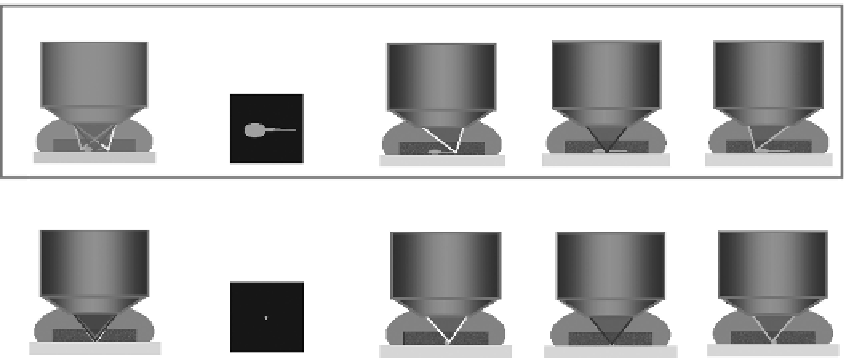Biomedical Engineering Reference
In-Depth Information
(a)
Scan position 1
Scan position 2
Scan position 3
Large fluorescent feature
=
Aberration averaged over
larger volume of tissues
Water-immersion
objective
Water-immersion
objective
Water-immersion
objective
Water-immersion
objective
(b)
Small fluorescent feature
=
Aberration averaged over
smaller volume of tissues
Scan position 1
Scan position 2
Scan position 3
Water-immersion
objective
Water-immersion
objective
Water-immersion
objective
FIGuRE 13.16
(a). For. luorescent. features. occupying. a. large. ield. of. view,. the. excitation. beam. probes. a. large.
volume. of. biological. tissue. during. correction.. he. measured. aberration. will. represent. an. average. over. this. large.
volume..(b).When.AO.correction.is.performed.over.a.small.luorescent.object,.the.excitation.light.probes.similar.
tissue. volume,. leading. to. a. correction. that. is. more. accurate. locally,. but. may. be. less. optimal. elsewhere. than. the.
wider,.ield-averaged.correction.
13.5.4 A Single-image Approach
Our.pupil-segmentation-based.approach.with.single-segment.illumination.has.many.similarities.with.
the.zonal.wavefront.sensing.approach.used.in.astronomy..hey.both.segment.the.pupil.and.measure.the.
local.wavefront.tilt.by.image.shit.and.can.derive.the.phase.using.phase.reconstruction..In.all.the.previ-
ous.examples,.we.measure.the.local.wavefront.tilt.one.at.a.time.by.turning.on.pupil.subregions.sequen-
tially..As.a.result,.we.take.multiple.images,.while.the.zonal.approach.in.astronomy.needs.only.one.image,.
since.in.a.Shack-Hartman.sensor,.the.diferent.areas.of.the.wavefront.are.measured.simultaneously..It.is.
possible,.however,.to.achieve.one-image.correction.using.our.method.as.well..Because.the.SLM.can.gen-
erate.a.large.wavefront.tilt.with.minimal.coupling.between.neighboring.regions,.we.can.apply.distinct,.
large.phase.ramps.to.each.subregion..he.excitation.light.relecting.of.the.SLM.then.forms.an.array.of.
foci.inside.the.sample..Scanning.the.excitation.light.then.gives.rise.to.an.image.composed.of.multiple.
images.of.the.luorescent.feature..If.there.is.no.aberration,.the.multiple.images.will.center.at.image.coor-
dinates.speciied.by.the.applied.phase.ramps..he.optical.aberrations.will.manifest.themselves.as.image.
shit.away.from.those.coordinates..
Figure.13.17
.
shows.an.example.of.such.one-image.AO.correction.for.
system.aberration.
13.5.5 Application to Superresolution Point-Scanning: SteD
Recent. years. have. seen. the. rapid. development. of. a. suite. of. superresolution. techniques,. both. point-
scanning.and.wide-ield,.which.can.provide.imaging.resolutions.of.tens.of.nanometers.[18]..Compared.
to. difraction-limited. techniques. with. resolution. of. hundreds. of. nanometers,. superresolution. tech-
niques.are.even.more.sensitive.to.aberration..For.the.point-scanning.superresolution.method.based.on.
stimulated.emission.depletion.(STED),.the.focus.of.a.luorescence.excitation.beam.is.overlapped.with.
a.donut-shaped-beam.that.depletes.luorescence.except.at.its.very.center,.thus.generating.an.excitation.
volume.below.the.difraction.limit..In.our.system,.if.we.do.not.correct.for.system.aberration;.the.focus.
of.such.a.depletion.beam.is.severely.distorted,.so.that.STED.microscopy.would.be.severely.compromised.
(
Figure.13.18
)..It.is.reasonable.to.say.that,.in.general,.the.same.aberrations.would.impact.superresolution.











